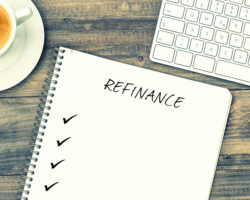Buying and financing a home are two of the most important decisions a household ever makes, and both call for a ton of hard work on your part. You might be tempted to think that things will go smoother after you finish the acquisition, that refinancing is just some phone calls and a couple of emails, but this is not true. Refinancing is actually the more complicated process. In fact, it can require so much paperwork that you might sometimes think it’s not worth it. But it is.
Refinancing can help you secure a lower interest rate, shorten the term of your mortgage, and it also gives you the opportunity to tap into your home’s equity. This article will guide you through the process step by step, to make it easier and to allow you to refinance your home without any headaches.
1. Figure out your refinance strategy
Before you start, it’s important to know why you want to refinance your home loan in the first place. Paying less on your mortgage rate is usually a good goal. That’s why many homeowners are often tempted to refinance with another 30-year loan. But this means that it will take even longer for you to pay off your home. And, as you probably already know, more time means more interest. You need to calculate how much interest you’ve already paid and how much you will pay with the new loan.
If you’re looking for a new mortgage, it’s imperative that you answer these questions:
a) How much have mortgage rates dropped and how much do you owe?
A lower drop in rates can mean a lot of money if you also owe a lot, and the savings have to justify the efforts and expenses of refinancing.
b) Do you plan to sell soon?
Refinancing may end up costing money if you plan to sell your house in the near future.
c) Can you refinance in a shorter term?
If you still have 20 years on your payment, it might not be such a good idea to replace that loan with a new, 30-year one, as it could end up costing you more. But, if you can replace your 30-year loan with a 15-year one, the savings could be large, especially if the new rate is lower.
Answering these questions can get you started on choosing the right refinance plan and help you avoid unwanted setbacks.
2. Learn your current credit score
Check your credit history and get your credit score. This is very important, because the better your score, the better the mortgage refinance interest rates you’ll be offered.
3. Find out your home’s current value
With the help of websites such as Zillow, you can see the current values of homes in your neighborhood. The Zestimate home value, Zillow’s estimated market value for an individual home, is calculated for about 100 million homes all over the United States. It can help you figure out or at least estimate how much your home is worth.
4. Use a mortgage calculator
One great tool that can make your life easier when looking to refinance is the mortgage refinance calculator. Once you are sure you want to refinance, you can use it to shop for the best mortgage.
The calculator just needs you to feed it the data (the new interest rate, fees, the new loan amount) and it will do the rest. This way, you’ll know what to expect. The tool will give you useful information, such as how much you can save or the exact number of months until you break even. It will also help you determine what lender offers you the better deal, providing you have a few estimates from those lenders.
5. Get as many offers from lenders as possible and pick the best one for you
Don’t settle for the first refi opportunity that comes your way. Chances are there are better offers out there. You want to get the best mortgage refinance rate. So open your browser, look for as many lenders as possible and ask for a loan estimate from each of them.
Lenders are required to issue an estimate within three days of receiving your information. These simple, three-page documents include loan terms, projected payments, estimated closing costs and other fees. You can compare details from each lender and choose the best one for you. The mortgage refi calculator will come in handy at this point.
6. Don’t be afraid to think outside the box – Use President Obama’s refi program
You also have the option to choose a government-sponsored mortgage refinance program. One very successful yet little-known such plan is the federal Home Affordable Refinance Program. A brainchild of the Obama Administration, HARP was launched in 2009, with the mission to help revitalize the housing industry after the last financial crisis.
The program offers homeowners the chance to refinance their mortgage no matter how little equity they have in their home. The only requirements are that homeowners must have conventional mortgages, with loans owned either by Fannie Mae or Freddie Mac, and they need to be current on their payments.
President Obama talked about HARP a few years back, during his “We Can’t Wait” speech. “There are still millions of Americans who have worked hard and acted responsibly, paying their mortgage payments on time. But now that their homes are worth less than they owe on their mortgage, they can’t get refinancing,” he said.
“If you meet certain requirements, you will have the chance to refinance at lower rates, which could save you hundreds of dollars a month, and thousands of dollars a year in mortgage payments,” the president explained, adding that “these steps aren’t a substitute for the bold action we need to create jobs and grow the economy, but they’ll make a difference.”
The program was hugely successful and was extended several times. So far, it has helped more than 3.4 million homeowners, by allowing them to save thousands of dollars each year.
Unfortunately, the program is now approaching its expiration date. HARP will end this year, on December 31, and it’s unlikely that it will be extended again. According to a recently released report from the Federal Housing Finance Agency, there are still more than 325,000 borrowers eligible for the program all over the US. Click here to see if it can help you too.
7. Gather the paperwork
People often believe this step to be an easy one. However, the digital age that we currently live in allows us to do our financial business online, which means little to no paper trail. You will need to download and print statements or whatever else the lender needs during the loan process.
8. Don’t forget you still need to have cash on hand
You still need to pay property taxes, insurance, closing costs or other expenses. Make sure that you set aside enough cash to cover them. These costs are usually listed in your loan estimates.
Refinancing your home is not an easy process and you should take it very seriously. By following these six steps you will be able to reach your goal faster and make sure you get the right refinancing plan for you.










